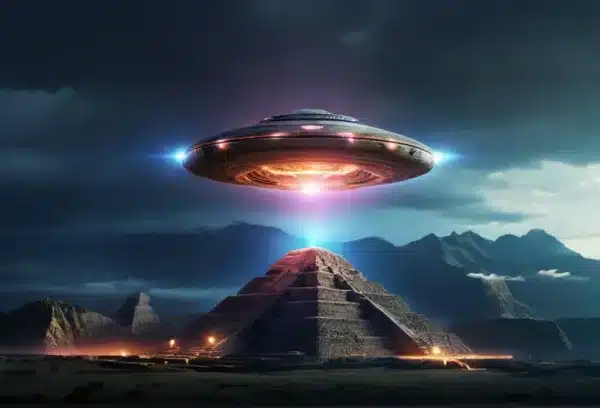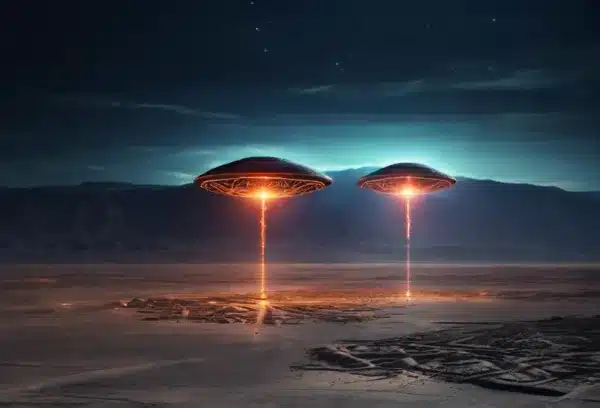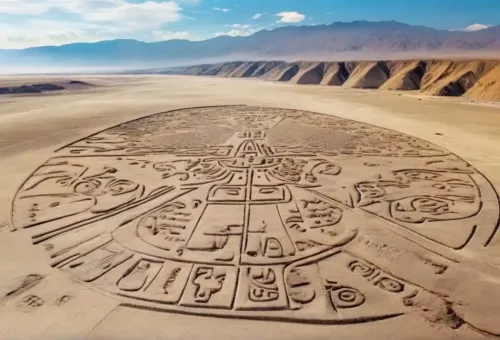- Introduction
- Nazca Lines: Mysterious geoglyphs
- Extraterrestrial influences in ancient civilizations
- UFOs in Peru: encounters and evidence
- The Maya and their connection to the cosmos
- Cultural and scientific impact
1. introduction
The Nazca Lines are mysterious geoglyphs in the Nazca Desert in Peru and a UNESCO World Heritage Site that attracts visitors from all over the world. Created between 500 BC and 500 AD by the Paracas and Nazca cultures, they cover around 500 square kilometers and include more than 800 straight lines, 300 geometric figures as well as 70 plant and animal designs, including famous depictions of a monkey, a spider, a hummingbird and a lizard [1]. The lines, which are best seen from the air, were created by removing dark-colored pebbles to expose the lighter sand beneath, and their meaning remains a mystery to this day. There are numerous theories about their purpose, including religious ceremonies, as an astronomical calendar or as a form of communication [1].
Despite their fragility and susceptibility to damage from vehicles, wind and water, the lines have stood the test of time and offer fascinating insights into the Nazca civilization [1]. There have been several incidents of damage in recent years, including in 2014, when Greenpeace activists left footprints near the hummingbird figure, and in 2018, when a truck driver drove off the road and damaged several lines [1]. These prehistoric artworks, which include various patterns such as geometric shapes, creatures and flora, still offer a unique aerial view today and attract adventurers and scholars alike who want to explore the mystery of their creation and purpose [2].
2 Nazca Lines: Mysterious geoglyphs
The Nazca Lines are a fascinating network of lines and geoglyphs drawn into the desert floors of Peru, depicting a variety of shapes and images. These mysterious drawings include:
- Geometric figuresMore than 800 straight lines and over 300 geometric figures that show impressive precision in their arrangement [5][6].
- Depictions of animals and plantsThe more than 70 biomorphic designs include images of a hummingbird, a spider, a monkey and a lizard. These figures vary in complexity and size, with the largest figures being up to 370 meters long [4][11].
- Human figures and spiral patterns: Some geoglyphs depict human-like figures, others show spiral patterns and animal symbolism often found in the Nazca Lines and other ancient Peruvian sites [12][13].
The Nazca Lines, created between 500 BC and 500 AD by the Paracas culture and later by the Nazca culture, were created by removing the darker stones and pebbles to expose the lighter sand underneath [1][5]. This method created a "negative" pictorial effect, making the lines and figures visible from the air, although they are also visible from surrounding hills and other elevated locations [4][13].
The exact meaning and purpose of the Nazca Lines remain a mystery, but scholars tend to attribute religious significance to them. There are theories ranging from astronomical purposes to water-related religious ceremonies. The lines could be related to rituals to ask for water, as the region is extremely dry [4][12][13]. Their preservation has been naturally aided by the region's dry climate and winds that sweep sand from their grooves [12].

3. extraterrestrial influences in ancient civilizations
The discussion about extraterrestrial influences in ancient civilizations is often enriched with fascinating evidence and controversial theories. A notable example is the presentation by Jaime Maussan Flota and Ryan Graves, who presented "evidence photos" of supposed aliens at the Mexican Congress. These bodies, which were found in Peru and are said to be 1000 years old, have DNA, a third of which could not be identified [17]. In addition, an osmium implant and the presence of eggs were mentioned [17]. The event, which was broadcast live on the Internet, was characterized by a serious tone and included scientists and a Harvard professor [17]. Nevertheless, there are doubts about the authenticity of the remains, as Maussan was already exposed as a fraudster in 2015 [18].
- Evidence photos and DNA analysesPresentation in the Mexican Congress with photos and DNA evidence of bodies found in Peru [17].
- Implant and eggs: Mention of an osmium implant and the presence of eggs as possible evidence of extraterrestrial life [17].
- Doubts about authenticityDespite the serious presentation, there are doubts about the authenticity of the remains due to previous cases of fraud [18].
Pre-astronautics, a para-scientific field that combines insights from archaeology and astronautics, investigates suspected extraterrestrial influences on ancient civilizations. This field involves the interpretation of religious and mythological texts as accounts of encounters with extraterrestrial beings and the reevaluation of archaeological artifacts and architectural structures as evidence of advanced technology [19]. Topics in pre-astronautics include:
- Interpretation of textsReligious and mythological writings are interpreted as reports of encounters with extraterrestrials [19].
- Archaeological artifacts: Reassessment of artifacts and structures as evidence of advanced technologies or extraterrestrial intervention [19].
- Opposing positions: Emphasis on commercial interests of key figures in the field, lack of empirical evidence and selective use of sources [19].
Despite the intriguing theories and alleged evidence, the discussion of extraterrestrial influences in ancient civilizations remains a controversial and speculative field. Pre-astronautics, although largely dismissed by mainstream scientists, has influenced both the scientific community and popular culture and continues to be a captivating topic for many [19].
4. ufos in Peru: encounters and evidence
Every month in Peru, hundreds of UFO sightings Julio Chamorro, the Peruvian Air Force's UFO investigator, considers at least half of them to be credible [20]. Chamorro believes that 60% of Peruvians have seen unusual celestial phenomena, and about a dozen a month are credible sightings with no simple explanations [20]. The Peruvian government has shown an interest in UFOs for decades, with Julio Chamorro leading a seven-person team investigating unusual aerial phenomena that could endanger aviation [20]. Chilca, 60 km south of Lima, is a UFO hotspotand the mayor hopes to capitalize on this by considering a partnership with Roswell [20].
- Credible sightingsHundreds of UFO sightings are reported every month, at least half of which are considered credible [20].
- Interest of the government: The Peruvian government has set up a team to study unusual aerial phenomena, which shows the serious interest in the matter [20].
- UFO hotspot Chilca: Chilca is known for its frequent UFO sightings, which has even led to considerations of a partnership with Roswell [20].
This information highlights the widespread interest and concern about UFOs in Peru and shows how seriously the phenomenon is taken by both the population and official bodies. The fact that a significant percentage of sightings are considered credible emphasizes the need for further investigation and may indicate a deeper connection between the Nazca Lines and possible extraterrestrial influences.

5 The Maya and their connection to the cosmos
The Mayan civilization, known for their profound astronomical knowledge and close connection to the cosmos, offers a fascinating field of study, especially when it comes to interpreting their art and architecture. Their highly developed script [21]together with a sophisticated Calendarsystem [22]The "sky," as it is known, testifies to a people who not only observed the sky, but also tried to establish a connection to it through their buildings and rituals.
- Astronomical systems and calendars:
- Calendar roundCombines a 260-day sacred cycle with a 365-day profane cycle [22].
- Long count calendarCounts the days from a fixed date in the past, with cycles from Baktun (144,000 days) to Kin (one day) [22].
- Prediction of solar eclipses: The Maya had a deep understanding of astronomy, which enabled them to predict such events [22].
- Cosmovision and Spiritual connections:
- Mayan cosmovisionA universe full of living, soulful systems with invisible qualities capable of manifesting material forms of life energy in the cosmos [23].
- Integration of the human beingMan is seen as an integral part of the living earth, which in turn is part of the solar system and the Milky Way [23].
- Holism and sustainability:
- SpiritualityMayan wisdom emphasizes the return to the natural essence of spirituality and recognizes the power of pure love and the wisdom of tolerance and compassion [23].
- Holistic life practicesTraditional Mayan practices recognize the importance of reverence for the living universe and the need to honor Mother Earth [23].
- Sustainable planetary awarenessLiving in sustainable harmony with our planet's biosphere is essential for humanity's future existence on Earth [23].
These elements underscore the profound connection that the Mayan civilization saw between humans, the earth and the cosmos. Their buildings and ritual practices reflect a complex understanding of the universe that goes far beyond what we often perceive in the modern world. The Maya teach us that the universe is a living, breathing entity with which we must live in harmony to ensure our own survival and well-being [21][22][23].
6 Cultural and scientific effects
The cultural and scientific impact of the Nazca Lines and the associated phenomena is far-reaching and multifaceted. They range from the promotion of local tourism to groundbreaking discoveries in archaeology and astronomy. The various animal symbols and references to extraterrestrials also play a role here, adding to the fascination and mystery surrounding these mysterious geoglyphs.
- Economic and cultural significance:
- TourismThe Nazca Lines attract thousands of tourists every year, which contributes to the local economy. The revenue supports the Conservation lines and promote the development of the region [6].
- World cultural heritageSince their recognition as a UNESCO World Heritage Site in 1994, the Nazca Lines have attracted worldwide attention. Maria Reiche, also known as the "Lady of the Lines", played a crucial role in the exploration and protection of this cultural site [6].
- Scientific research and discoveries:
- Archaeological researchThe lines are an important object of research in archaeology and astronomy. The discovery of over a hundred new geoglyphs and the application of AI and machine learning in the study of these geoglyphs open up new avenues for future research [10].
- Theories about the lines: Various theories, including astronomical and religious purposes, emphasize the complexity and mystery of the Nazca Lines. The discovery that the tradition of creating geoglyphs in the region dates back to a thousand years before the Nazca culture expands the understanding of South America's pre-Columbian history [9][11].
- Conservation and challenges:
- ThreatsNatural erosion, climate change and human activities such as agriculture and urban development pose serious threats to the Nazca Lines [6].
- Protective measuresContinuous efforts to protect and preserve these ancient geoglyphs are crucial to ensure their survival for future generations. This includes overcoming the challenges posed by increasing tourism [6].
These aspects shed light on the diverse impact of the Nazca Lines on culture, science and society. Their fascination extends far beyond the borders of Peru and inspires people around the world to learn more about the secrets of our past and to appreciate the significance of this extraordinary cultural site.
Further questions and answers about the Nazca Lines
What is the purpose of the Nazca Lines?
The Nazca Lines, a collection of over 70 drawings, were probably created by pre-Columbian peoples as a form of worship to the gods. These impressive scarified images vary in their depiction from simple lines to detailed figures such as a hummingbird (66 meters), a spider or a monkey (135 meters).
How many Nazca lines and figures are there?
More than 1,500 geoglyphs have been documented in Nazca to date. These fascinating lines and geometric figures extend over an area of 500 square kilometers in southern Peru, with the figures measuring up to 1.9 kilometers and the lines up to 10 kilometers long.
How deep are the lines of the Nazca Plain?
The more than 1,500 striae, which bear the name of the nearby town of Nazca, cover an area of more than 500 square kilometers. These lines, which can be up to 20 kilometers long, are only a few centimeters deep.
Where is the Nazca Plain located?
The Nazca Plain, where the famous Nazca Lines are located, lies in the desert near Nazca and Palpa in Peru. These more than 1,500 huge geoglyphs, which are only visible from the air or from surrounding hills, are named after the town of Nazca, which is located in the immediate vicinity of the plain.
References
[1] – https://de.wikipedia.org/wiki/Nazca-Linien
[2] – https://www.exploorperu.com/de/blog/sehenswuerdigkeiten-peru/geheimnisse-nazca-linien/
[3] – https://www.viator.com/de-AT/tours/Lima/Nazca-Lines-Air-Tour-with-Transport-from-Lima/d928-5243NAZCA
[4] – https://en.wikipedia.org/wiki/Nazca_Lines
[5] – https://www.nationalgeographic.de/geschichte-und-kultur/2018/05/sieben-antike-staetten-die-angeblich-von-aliens-erbaut-wurden
[6] – https://www.deutschlandfunk.de/nasca-kultur-raetselhafte-linien-in-peru-100.html
[7] – https://www.nationalgeographic.de/geschichte-und-kultur/nasca-linien-graffiti-fuer-die-goetter
[8] – https://www.faz.net/aktuell/wissen/archaeologie-altertum/nazca-kultur-wer-schuf-die-geoglyphen-15586918.html
[9] – https://www.spiegel.de/wissenschaft/mensch/peru-forscher-entdecken-neue-nazca-linien-a-1202290.html
[10] – https://www.br.de/radio/bayern2/sendungen/iq-wissenschaft-und-forschung/nazca-linien-peru-100.html
[11] – https://peru-spezialisten.com/die-nazca-linien-das-achte-weltwunder-der-atakama-wueste-perus/
[12] – https://www.britannica.com/place/Nazca-Lines
[13] – https://www.nationalgeographic.com/history/article/nasca-lines
[14] – https://www.history.com/topics/south-america/nazca-lines
[15] – https://whc.unesco.org/en/list/700/
[16] – https://www.machutravelperu.com/blog/nazca-lines-theories
[17] – https://www.geo.de/wissen/forschung-und-technik/aliens-im-mexikanischen-parlament–ufologen-zeigen–beweisfotos–33822890.html
[18] – https://www.rnd.de/panorama/mexiko-alien-leichen-im-parlament-ufologe-praesentiert-beweise-4HT4VOP2HBLYRE65ZLLV63RBTY.html
[19] – https://de.wikipedia.org/wiki/Pr%C3%A4-Astronautik
[20] – http://www.forum-3dcenter.org/vbulletin/archive/index.php/t-57771.html
[21] – https://en.wikipedia.org/wiki/Maya_civilization
[22] – https://www.mayanleague.org/maya-cosmovision
[23] – http://www.yucatanadventure.com.mx/Maya-Cosmovision.htm
[24] – https://de.wikipedia.org/wiki/Liste_von_UFO-Sichtungen














